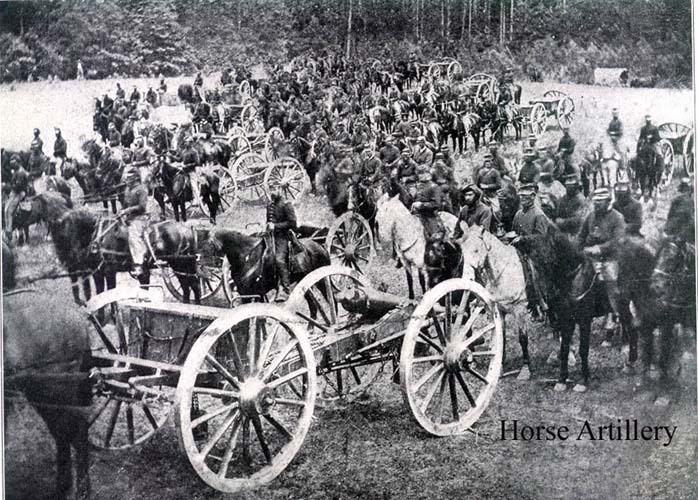Organization of Artillery

Six Gun Field Artillery Battery
3rd U.S. Artillery, Battery C

The organization of field artillery during the Civil War was built around the battery rather than the regiment, which was the basic organizational unit for cavalry and infantry. It was decided early in the war to accept volunteer units as batteries rather than regiments. Volunteer regiments existed only on paper. Units might have names such as Battery A of the 1st Rhode Island Light Artillery, but there were no regimental staff or field officers mustered into federal service. This was true only for volunteer field artillery units. Regimental organizations existed for the Regular Army and for volunteer heavy artillery units. The result of this decision was that there was little hope of promotion for artillerists beyond that of a company grade officer.
The typical battery had six guns of the same type. These were line-of-site weapons. One needed to see the enemy and, of course, the enemy could see the artillerist. Proper use of terrain and rapid teamwork of gun crews was critical to the survival of both man and beast on the hostile battlefield. Once deployed artillery drew counter battery fire from the opposing artilery and also from opposing infantry skirmishers, once they were able to work their way into some cover within range of the gunners. The commander of a battery was its captain. Three of his four lieutenants commanded a two gun section each. The fourth lieutenant supervised the line of caissons and reserve ammunition for the battery. The sergeants each commanded a gun crew and was called the "Chief of the Piece" (cannon). Each gun and its limber (a two-wheeled vehicle which pulled a gun) or each limber and caisson (a two-wheeled vehicle holding reserve ammunition and an extra wheel) had a corporal assigned to it. The corporal of the piece served as the gunner. The privates were mostly divided into cannoniers and drivers. Teams of cannoniers were assigned numbers one to seven and each number had a specific function in working the weapon. Drivers controlled the six horses needed to pull the gun into position. Each limber had a three men team of drivers who rode the left sided horses. A well-drilled battery, both man and horse, worked like a precision watch. Those to whom I have spoken who witnessed Regular Army horse drawn artillery in action, prior to artillery becoming motorized, testify that it was an impressive sight. It is little wonder that Civil War artillery soldiers had a great deal of pride in their units.
Two types of field artillery units existed. A mounted battery was assigned to infantry. The cannoniers generally walked beside the guns, although occasionally they might sit on a limber. The drivers were the "mounted" element. This was distinct from fortress or heavy artillery, which was in fixed positions and had no mounted drivers. The other type of field artillery was the horse artillery battery, which was designed to operate with cavalry. Horse artillery cannoniers, as well as the drivers were mounted.
The photograph above is a horse artillery battery. The cannoniers are mounted and in a group behind the guns. Two battery officers can be seen. Artillery was dependant on the other branches of service for its protection. Typically, cannoniers were trained to depend on their cannon as a weapon and were not issued rifles. Batteries were pulled back when opposing infantry closed with them. It was a mark of a poor unit to allow itself to be overrun and have its guns captured.
Personnel of an Artillery Battery